Dreamcatchers are a decoration, both fascinating and mysterious, that is becoming increasingly popular and appreciated: you have surely saw some of them hanging in some hippi beach bar, or in some traveler’s homes, or even in some campervans (we have 3 in ours alone!).
So many people even choose to tattoo a dreamcatcher on their skin!
Not everyone knows, however, that the dreamcatcher is not only a delicate and whimsical decoration, but also an ancient symbol that holds a mystical, mysterious and meaningful story.
In this article, I want to briefly tell you everything you should know about the history of dreamcatchers, their general meaning and the symbolism behind each of their components (circle, net, feathers, weaves etc.), so that you will appreciate this ancient amulet even more when you see one🙂
1. The Story of the Dreamcatchers: Where do they come from?
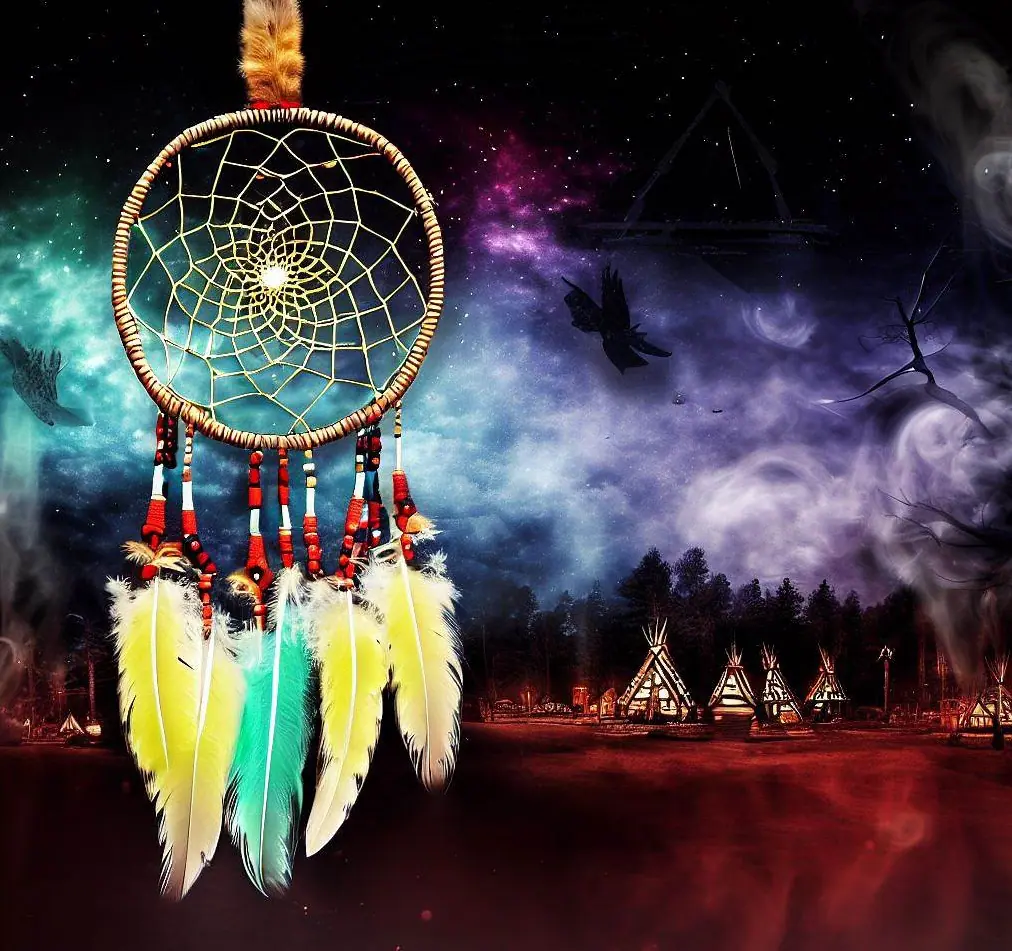
What is currently certain is that the story of dreamcatchers has its roots in Native American culture (or “Indian culture” as children here in Italy would still mistakenly call it).
Unfortunately, there is no specific date to tie their appearance to, but there are various versions of the story about their origin: some attribute their creation to aspider-woman of the Ojibwe tribe who taught her people how to sew, while others attribute the origin of the dreamcatcher to a spiritual leader of the Lakota tribe.
Below, find a brief history of the dreamcatcher and a summary of the most credited legends :).
DREAMCATCHERS WERE BORN WITH THE “OJIBVE” TRIBE: LEGEND OF THE SPIDER-WOMAN
The Objiwe Tribe is the most populous Native American community in all of North America.
Its exponents live in both the United States and Canada, occupying some of the land around the Great Lakes, including parts of Minnesota, Wisconsin, Michigan, North Dakota and Ontario. To date, the current population of the Objive people is around 320,000.
This tribe calls dreamcatchers “asabikeshiinh,” which means “spiders.”
In fact, according to one of their legends, there was a time in the past when a spider-woman named Asibikaashi constantly took care of all the Ojibwe people and their children.
As time passed and the tribe expanded, however, it became increasingly difficult for her to protect everyone.
No longer able to go by each individual child to protect them from evil spirits, as the tribe had expanded too much geographically, the spider-woman asked all the mothers in the tribe for help.
All the mothers and grandmothers of the Ojibwe tribe, set about creating “dream catchers” for their babies, weaving webs to hang above each bed.
In this way, they helped the spider-woman Asibikaashi protect all the little ones from nightmares and bad dreams.
HANDED DOWN TO THE “LAKOTA” TRIBE.
The Lakota Tribe, is another Native American tribe living between the U.S. and Canada, in parts of the states of North Dakota, South Dakota, Minnesota, Nebraska, and Saskatchewan. To date, there are approximately 100,000 people belonging to this tribe.
According to historians, the dreamcatcher is an amulet that was invented by the Objive tribe and then passed down to the Lakota tribe through relations between the two tribes. On the contrary, the Lakota tribe claims its creation, and we will probably never really know who was the inventor of this mysterious ornament.
The Lakota tribe, offers its own original legend about the origin of dreamcatchers.
According to Lakota legend, a leader of the tribe had a vision of Iktomi, a spiritual guide who delighted in transformations and sleight of hand. In the dream, Iktomi took the form of a spider.
At that point, the spiritual guide took a circle of willow (the sacred plant the natives used to make arrows, containers, and other ornaments) and began to weave a web with it. During the weaving, Iktomi explained to the Lakota leader the logic of the circle of life, and how in life there are both positive and negative forces that are intertwined.
“If you follow the positive forces, you will go in the right direction! If you follow the negative ones, you will cause pain,” he told him.
Once the web was finished, Iktomi displayed his creation: it was a perfect circle with a central hole created by the interweaving of the threads. Then, he explained to the leader that good ideas (dreams!) would filter through the web, while bad ones (nightmares) would inevitably be caught by the web.
The Lakota leader brought the story of his experience to his entire tribe, which from that day began using dream catchers to filter dreams, letting the good ones through and trapping the bad ones.
ALL THE WAY TO THE PRESENT DAY AS “SOUVENIRS”
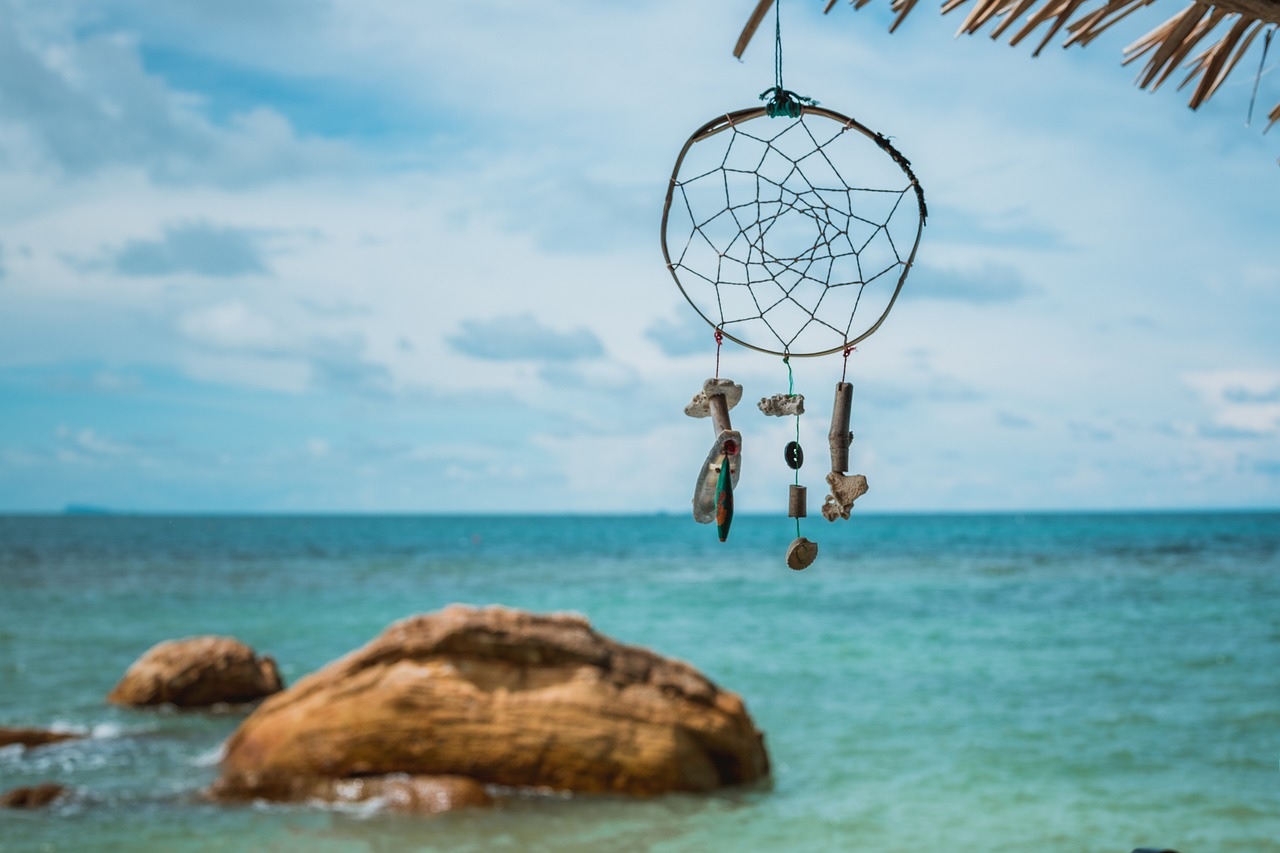
After the legends, we come now Toward the present day.
Nowadays, dreamcatchers, as we know them, are very popular ornaments that can be found a little bit all over the world.
You’re probably wondering how, from indigenous tribes these amulets achieved the notoriety and popularity they enjoy today. More than fair question I would say!
Well, dreamcatchers were used at the turn of the 1960s-70s’ as a symbol of unity by the Pan-Indian movement (a collection of tribes advancing the common rights of all Native Americans) and became popular souvenirs during those years.
Moreover, in the same years that the dreamcatcher symbol was spreading as a symbol of unity and independence, “hippie” culture, a revolutionary movement for that processed love and nonviolence, values very similar to those of the Pan-Indian movement, was spreading in the Western world.
This mix of overlapping movements in the same years surely was an impetus for the dreamcatcher that helped its spread beyond indigenous borders and throughout the West.
THE NEW-AGE TREND AND THE UNION WITH OTHER MATERIALS AND CULTURES

From the 1960s onward, after the Western world entered what is culturally called the “New Age” (a set of counter-cultures of spiritual renewal), the original structure of dreamcatchers began to change.
Coming into contact with other cultures in fact, the “original” Native American dreamcatcher began to be reinvented again and again, until it arrived in the present day in the many variations, colors, shapes and materials that we can still admire today.
From being a religious symbol of a minority, the dreamcatcher has thus become an accessory adopted globally by various cultures and sub-cultures, and to date there are so many different shapes, and so many different materials.
Compared to the original “Native” dreamcatchers (small, wooden, very “basic,” and with real feathers), many dreamcatchers found on the market today are very large, colorful, and unfortunately, often entirely machine-made using artificial materials that have little to do with the concept of a call to nature with which these talismans were born.
Certainly, before buying a dream catcher it is therefore important to understand its various meanings, understand its history and the symbolism of its various components🙂
2. What is the Symbolic Meaning of Dreamcatchers?
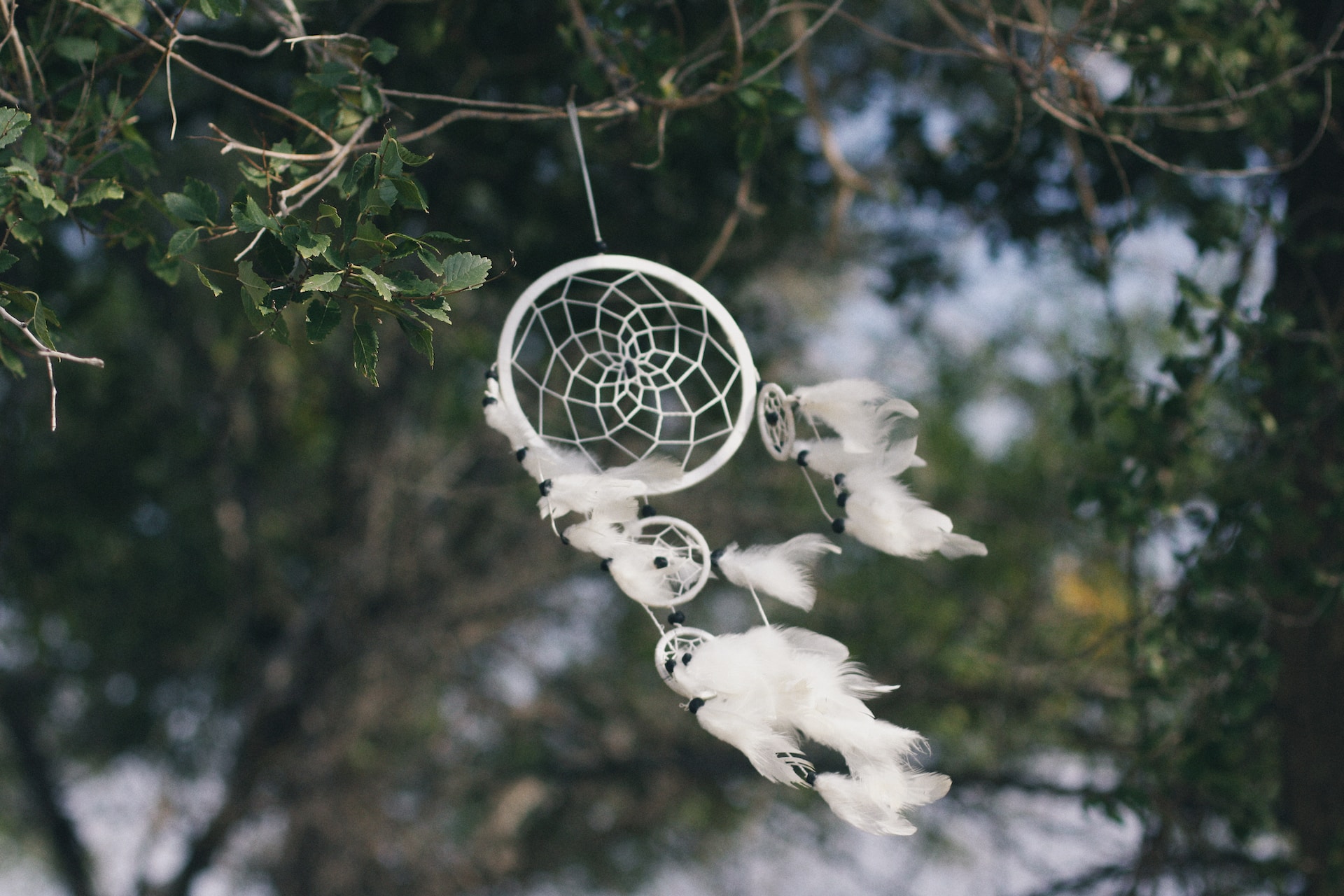
THE MEANING OF ALL DREAMCATCHERS: WHAT ARE THEY FOR?
According to Native American legends, dreamcatchers are objects with supernatural powers that are used to protect people by filtering their dreams: By hanging a dream catcher above the bed, positive dreams are allowed to pass to the person during the night, while nightmares and malignant energies are trapped in the net.
CONTEMPORARY USE: ORNAMENT RELATED TO DREAMS
Nowadays, dreamcatchers are still used by Native Americans as a symbol of protection, good luck and peace.
That said, in other cultures (including Western cultures). curiosity about something that is seemingly extravagant, light and elegant has led to the adoption of these instruments not only as talismans to hang above the bed, but also as decorative ornaments that evoke values of peace, lightness and freedom for homes, clubs and as well in many mobile homes.
Last but not least, the manual weaving of dream catchers is now also a form of art and expression that has blended with other traditions and religions.
Examples are macramé dreamcatchers (a form of hand weaving typical of Arab cultures), or dreamcatchers with shells (representing the passage to the other world in Christianity and Buddhism) or even dreamcatchers with mandalas (inspired by India and the Hindu universe).
3. The Shape of the Dreamcatcher
encompasses many minor Meanings
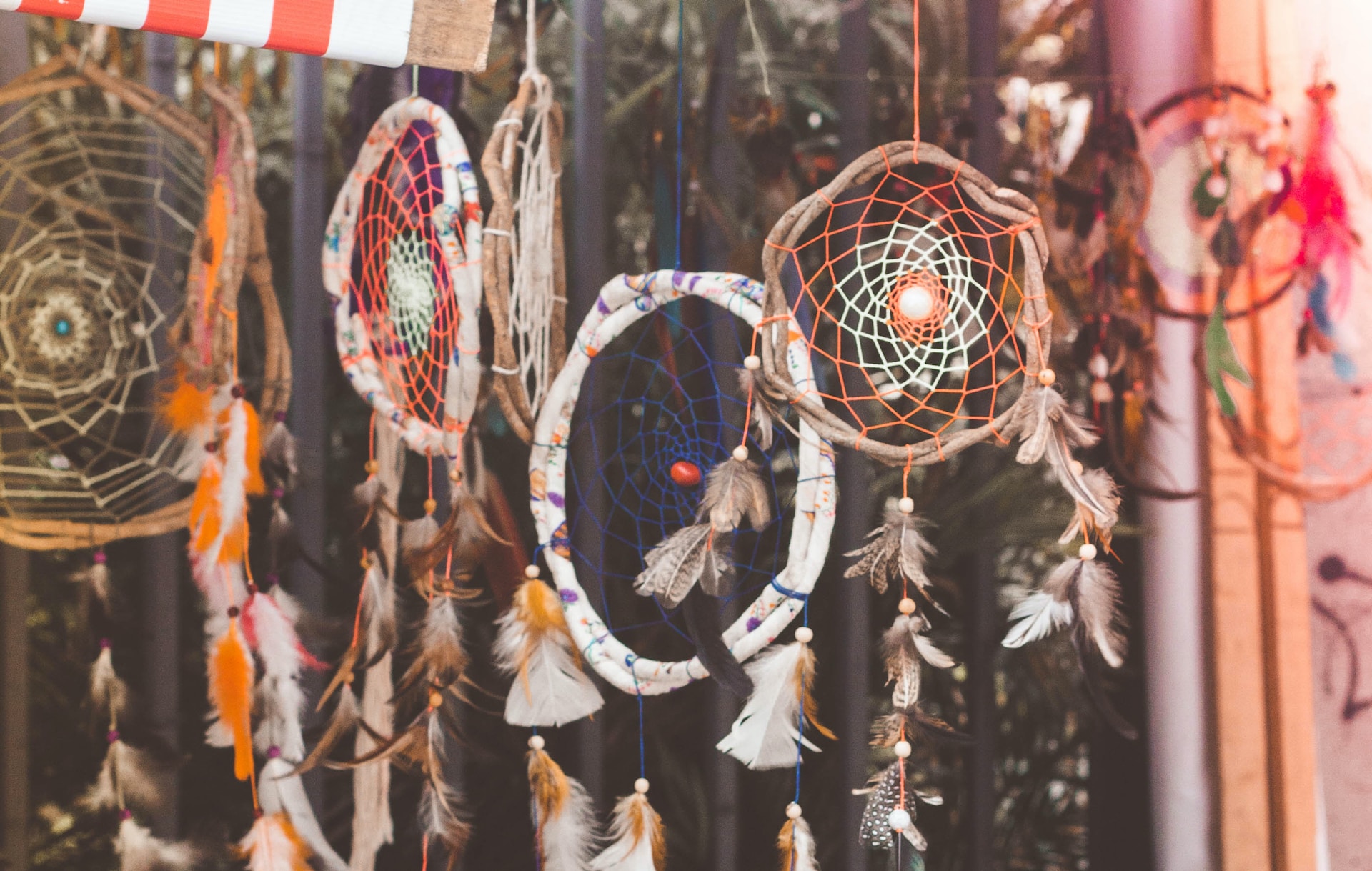
The reasons why dreamcatchers (or “Dreamcatchers” in English) probably attract so much of our human attention are to be found in the complicated interweaving of materials that, without a thorough knowledge of their history and symbolism, may seem simply meaningless.
In contrast, according to Native American traditions, each part of a dreamcatcher has its own function and invokes a specific dogma or concept of indigenous beliefs. Below you will find the symbolism of the components of dreamcatchers according to the Ojibwe and Lakota tribes 🙂
THE CIRCLE: LIFE!
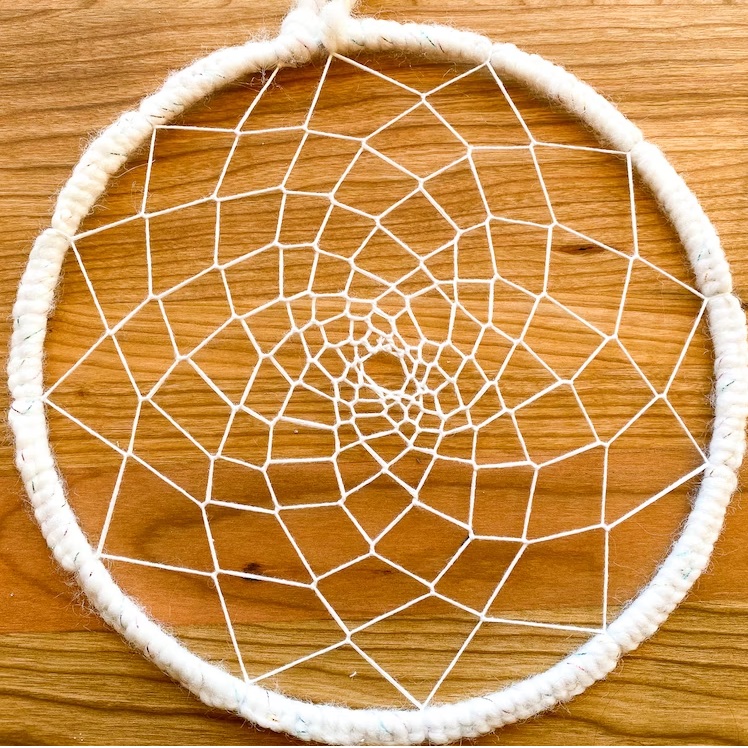
The large central circle is definitely the first thing that jumps out at you when looking at a dream catcher.
This circle, represents the circle of life that continuously repeats itself, with no real beginning or end-a very important concept for Native Americans!
Dreamcatcher circles, were traditionally created by the Ojibwe tribe using red willow wood, which is very flexible and easy to bend. Nowadays, however, most hoops are made of metal or generic wood.
THE NET: THE FILTER OF DREAMS!
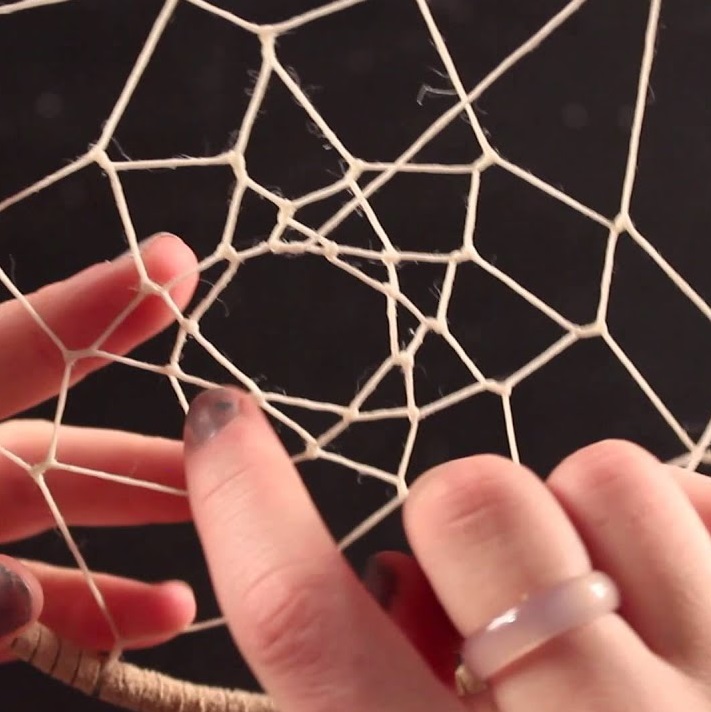
The net is the component of dream catchers that, according to Native American legends, essentially performs the main function for which these objects were created: filtering dreams and good energies from nightmares, curses and evil spirits.
Just as a spider’s web serves to catch prey, so the dreamcatcher’s web serves to prey on nightmares and prevent them from reaching its possessor. The center of the net, on the other hand, is considered the “heart” of the dreamcatcher and the passageway through which dreams and visions filter down to the person’s mind.
Besides this, the net (usually made of thread, wool or cotton) is also a tribute to Asibikaashi, the spider-woman, according to Ojibwe belief.
THE ANCHOR POINTS OF THE NET: MOONS, SPIDERS, EAGLES AND STARS!
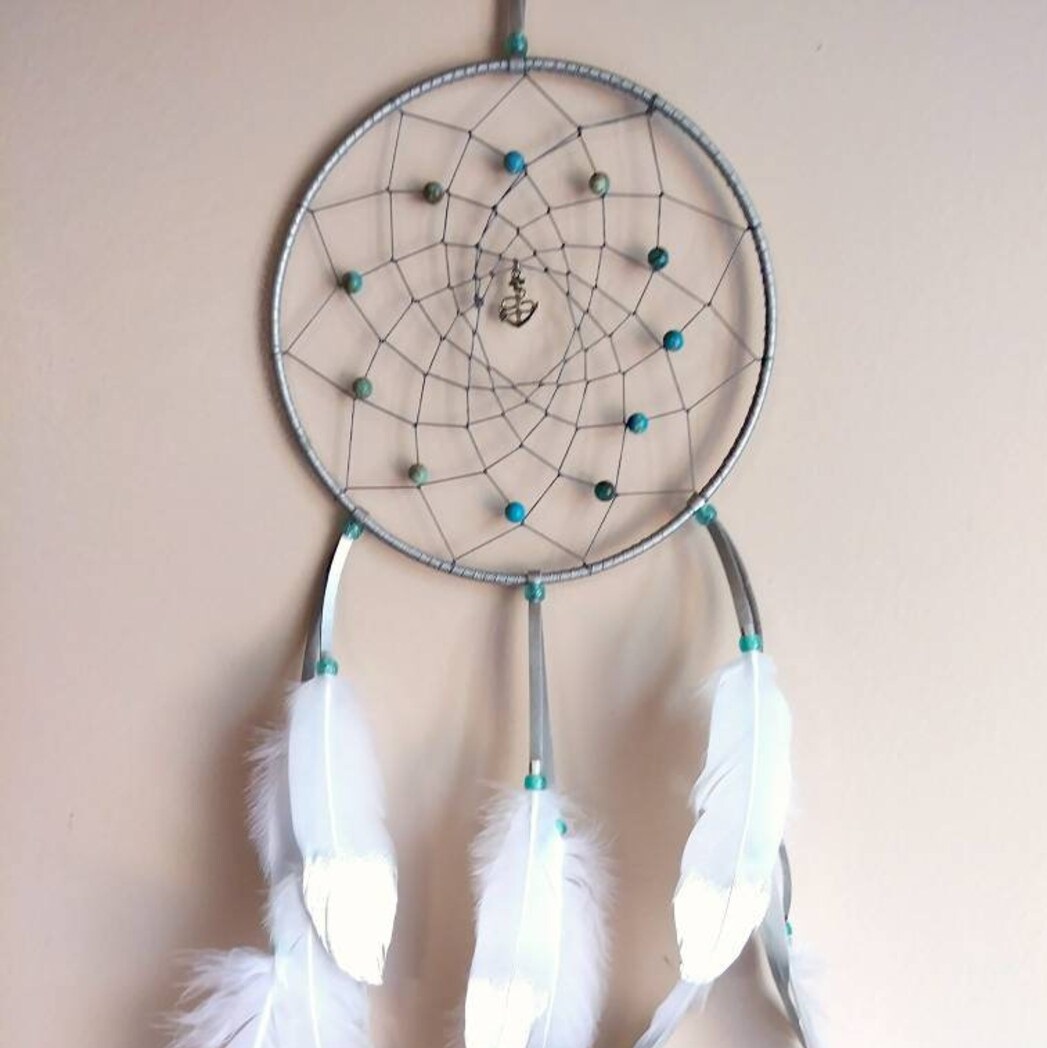
A detail that may go unnoticed by the less observant, but which originally held meaning in indigenous cultures, was the number of anchor points that the net had on the circle of life.
The meanings were as follows:
- 4 points represent the four sacred directions
- 5 dots represent a star in the sky
- 6 dots represent an eagle
- 7 points represent the 7 prophecies of fire
- 8 dots represent the spider-woman (spiders have 8 legs!).
- 13 dots represent the 13 phases of the moon
Nowadays, after decades in which the spiritual object of the dreamcatcher has mixed with a varied number of cultures (there are Arab dreamcatchers, Asian dreamcatchers, European dreamcatchers etc.), one can find nets with a number of anchor points different from the traditional ones.
This, is sometimes coincidental (the artist does not know the history of dreamcatchers or is more interested in aesthetic form than meaning) or intentional (the artist wants to give the dreamcatcher its own meaning).
THE PEARLS: THE IMMORTAL DREAMS
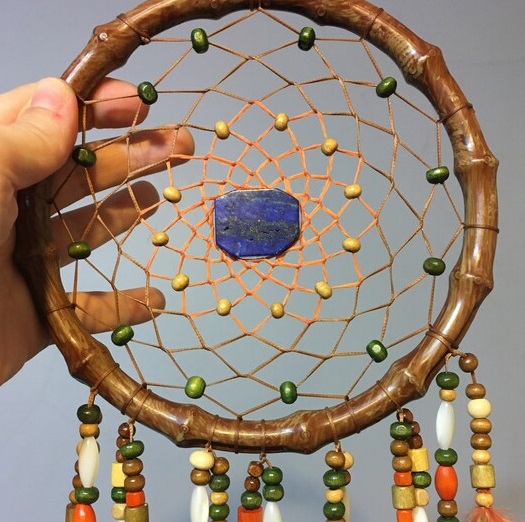
Each dreamcatcher usually contains a few pearls in its complicated weave, and there are various schools of thought that explain what these stand for.
In the case of a single bead, this is thought to represent the spider who spun the web.
On the contrary, if more beads are found on the dreamcatcher, they represent “immortal dreams,” that is, those wonderful dreams that mark our lives from time to time and turn into memorable travel memories and sacred amulets 🙂
FEATHERS: THE AIR THAT MAKES DREAMS DESCEND
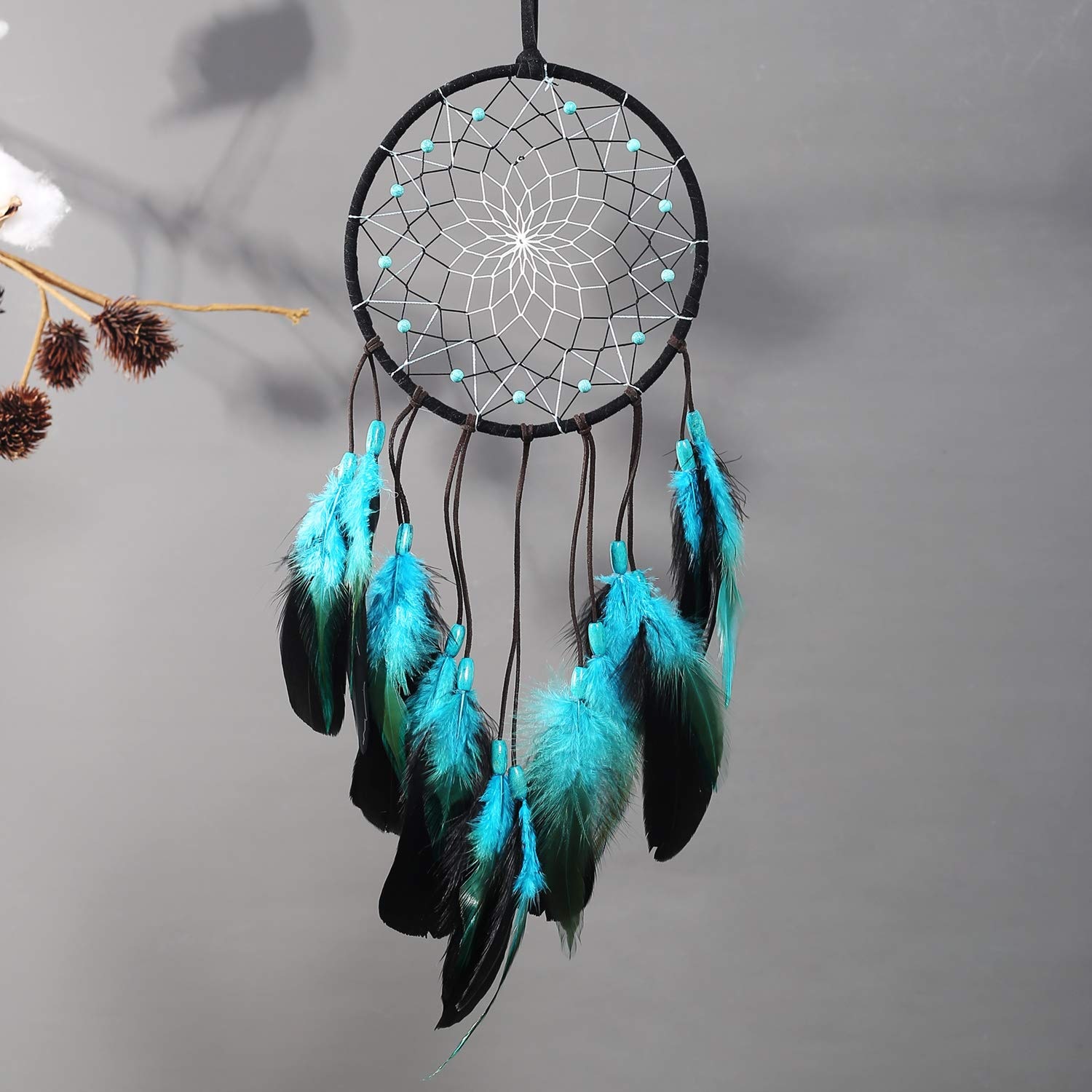
Feathers are the detail of dreamcatchers that definitely adds more lightness, sense of freedom and why not, even a touch of whimsy to it.
Feathers, however, like everything else, are not simply an ornament; they also have a deep meaning.
In fact, the feathers hanging from the circle and pointing downward represent the air and breath of life that help beautiful dreams to filter through and gently descend to the person sleeping below .
In Native American culture, peacock, eagle, pheasant, macaw, goose or even eagle feathers were used.
The correct choice of feathers and their color, was traditionally to be associated with the meaning they carried for the dreamcatcher owner and his or her relationship with the animal.
STONES, SHELLS AND GEMS
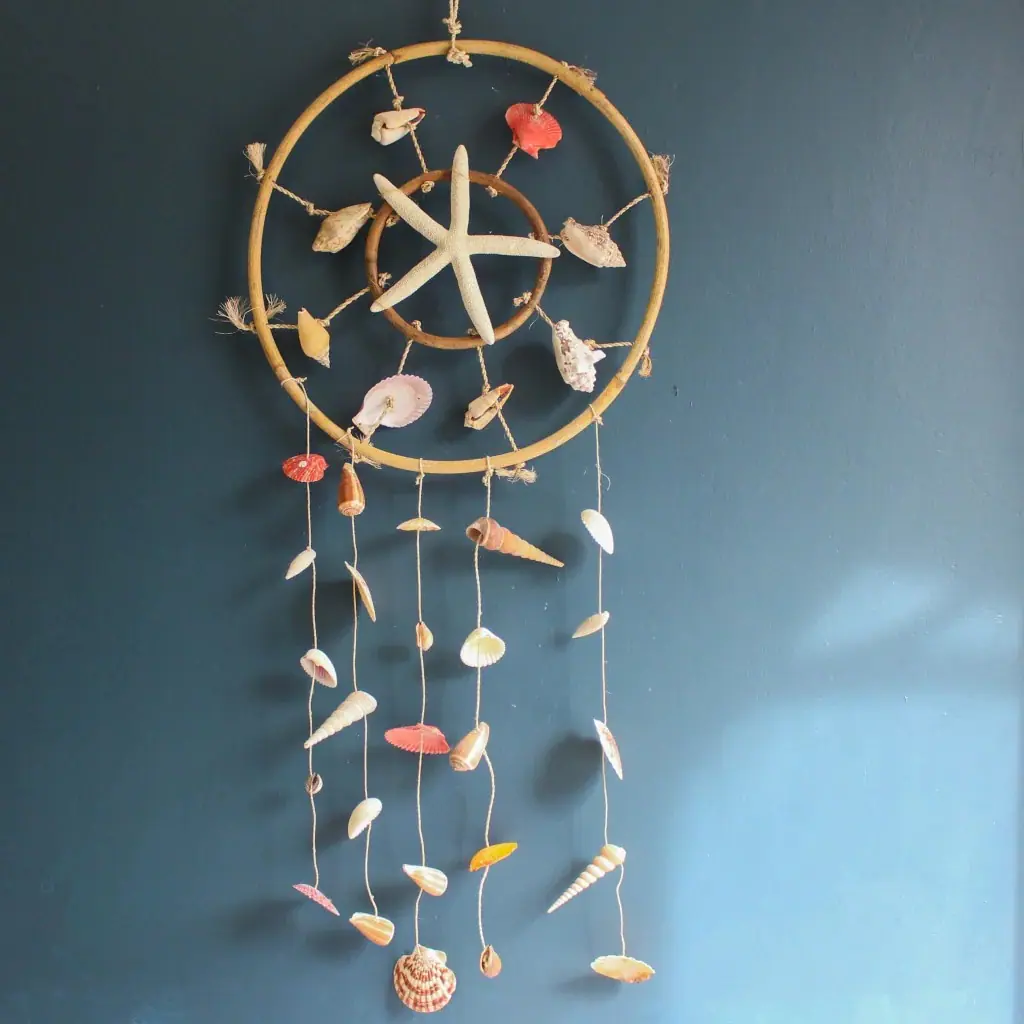
Feathers are the detail of dreamcatchers that definitely adds more lightness, sense of freedom and why not, even a touch of whimsy to it.
Feathers, however, like everything else, are not simply an ornament; they also have a deep meaning.
In fact, the feathers hanging from the circle and pointing downward represent the air and breath of life that help beautiful dreams to filter through and gently descend to the person sleeping below .
In Native American culture, peacock, eagle, pheasant, macaw, goose or even eagle feathers were used.
The correct choice of feathers and their color, was traditionally to be associated with the meaning they carried for the dreamcatcher owner and his or her relationship with the animal.
THE WEAVES: AN ARAB INFLUENCE!

The elaborate weaves of cotton threads that can be seen in the most elaborate of dreamcatchers are not really typical of Native American culture, but derive from a fusion with the Arabic tradition of macramé.
The color of the threads used and the various combinations of weaves, as in the case of gems, do not have a common meaning for all dreamcatchers, but are attributed from time to time by the creator of the spiritual object.
CONCLUSION: THE LAST MEANING IS UP TO YOU!
Now that we have seen all the various meanings and symbolisms of dreamcatchers, one final note: since these objects are part of the mystical and spiritual world (thus something you have to believe in, to see them work!), the ultimate meaning to a dreamcatcher is for you yourself to ascribe!
Many people, in fact, decide in the course of their lives to learn how to make do-it-yourself dreamcatchers, either as a manual hobby, but especially to have the opportunity to customize their own dreamcatcher according to their own preferences.
Once you understand the history of these accessories and always respect their sacred meaning for some minorities, now you too will probably be able to look at these beautiful talismans with different eyes and appreciate the symbolic value they carry! 🙂
4. How to “Use” a Dreamcatcher?
Using a dreamcatcher is super simple: all you need to do is hang it above your bed (or that of your loved ones/children), in the office, or in the area of the house you want to protect.
The dreamcatcher is a good-luck amulet, which supposedly will keep bad energy and nightmares away, giving you inner peace and a sense of light wholeness.
According to indigenous beliefs, the dreamcatcher should be hung in a spot where the sun shines at least once a day.
In this way, the sun will be able to “purify” the net by removing in the morning all the negative energies trapped there during the night, and prepare the dream catcher for the next day.
HOW LONG DOES A DREAM CATCHER LAST?
If kept well, a dream catcher can last several years or even a lifetime!
That said, according to tradition these should be changed periodically to follow the stages of a person’s life and to give a “worn out” dreamcatcher a chance to repair.
One sign to know when it is time to change a dream catcher is the appearance of nightmares during the night or restlessness during sleep.
Of course, if you choose to hang a dreamcatcher solely as an ornament for purely aesthetic taste, it will last until you get tired of seeing it hanging😉
Conclusion

And here we come to the end of this long article on the meaning of dreamcatchers.
Symbols, magical, spiritual, good luck, ancient and at the same time revisited.
I hope this article was clear enough and helpful enough for you to fully understand what dreamcatchers are and all the history and symbolism they encompass.
And have you ever owned a dreamcatcher? Do you believe in their spiritual power or do you just find them interesting as aesthetic ornaments and art forms? Do you have other questions on this topic that were not answered?
Let us know in the comments below! 🙂
As always, I thank you for reading, and I wish you much happiness and good path! 😀
See you in the next article! 🙂
LEARN MORE:
BEFORE YOU GO, CAN I ASK YOU FOR SOME FEEDBACK?
Writing detailed articles like this takes a lot of time and effort..
If you liked it, can I ask you to leave me a feedback message in the comments at the bottom of the page?
For a content-creator, knowing that you are being read and that your efforts are useful to someone is the best motivation to keep writing and doing better 🙂
Let me know what you liked or what you think could be added.
If you’d like, you can also share the article to help other people find it!
Thanks for the help 🙂

Read the Van Conversion Guides
The Best Beaches in Puglia and How to Get There
Every region of Italy is special in its way, and Puglia is no exception! Assaulted by Italians in summer, and increasingly discovered by more and more international tourists every year, this southern region has a lot more to offer than what meets the eye! To name a...
TOP 11 Places for Hot Air Balloon Rides Around the World
Only a few things can compete with a hot air balloon ride when it comes to a breathtaking, memorable and unforgettable experience! Floating in the sky light as a feather, taking panoramic views of magnificent landscapes and feeling the gentle breeze on your face is a...
Discover the Wonder of Amazon Plants on an Amazon River Cruise
The Amazon rainforest is one of the most biodiverse regions on Earth, and the Peruvian Amazon is no exception. It is home to an incredible array of exotic plants that captivate the imagination and leave visitors in awe. In this article, we will explore some of the...
Visit the Last Supper in Milan | Tickets and Free Pocket Guide!
The Last Supper, painted by Leonardo da Vinci between 1495 and 1498, is one of the most famous and revered artworks in history! After all, who never saw it on school's books, in popular movies or revisited more recently as an internet meme? I guess, nobody older than...
Conero Riviera | The Most Beautiful Beaches | Discover What To See
The Conero Riviera in Italy is an incredible touristic destination that attracts more and more visitors every year, thanks to its unique views, crystal clear water, hospitality, and good food. After visiting and seeing it with our own eyes, we can only confirm what...
Conero Riviera | The Most Beautiful Beaches | Discover What To See
Trabocchi Coast in Abruzzo: All The Most Stunning Beaches!
"Stretched from the rocks, Similar to a lurking monster, With its hundred limbs, the trabocco looked formidable." - GABRIELE D'ANNUNZIO (Italian Poet) TRABOCCHI COAST: WHICH ARE THE MOST BEAUTIFUL BEACHES? The Trabocchi coast, which stretches between...
Madonna della Corona, Italy: Discover the Magical Church on the Mountain
Not far from Verona and the eastern coast of Lake Garda, hides the sanctuary Madonna della Corona, an incredible place that appears straight out of a fairy tale: a church on the mountain set in the rock above a very high cliff! In this guide, I want to tell you how to...
The Bauxite Quarry | Discover the Martian Pond near Otranto, Italy
Today I'm going to tell you about a place we discovered a bit by accident while driving on the coast of Apulia: the Bauxite Quarry! You're probably already wondering what it is, as we also did when we first heard of it! Let's say it's really an experiencefrom another...
Lago di Braies: How to Visit the Pearl of the Alps
Where Is Lago di Braies? Lago di Braies, also called "Lake Braies" in English or "Pragser Wildsee" in German, is an alpine lake located between the Dolomites of South Tyrol (in Italy) and not far away from the Austrian border. Content Summary Famous for its...
Lake Tovel: Where Is It and Everything you Need to Know
Where Is Lago di Tovel? Lago di Tovel (also referred to as Lake Tovel in English) is one of the most charming alpine lakes of the Dolomites and it is located within the Adamello Brenta Natural Park in Trentino, Italy. Content Summary Lake Tovel got famous...
Visit Matera in Italy: The Magical City of Stone
Where Is Matera? Matera, also known as the "City of Stone", is located in the Southern Part of Italy, in the Region of Basilicata. The city, until a few decades ago one of the poorest areas in Italy, has seen in recent years a surge in popularity that brought it...

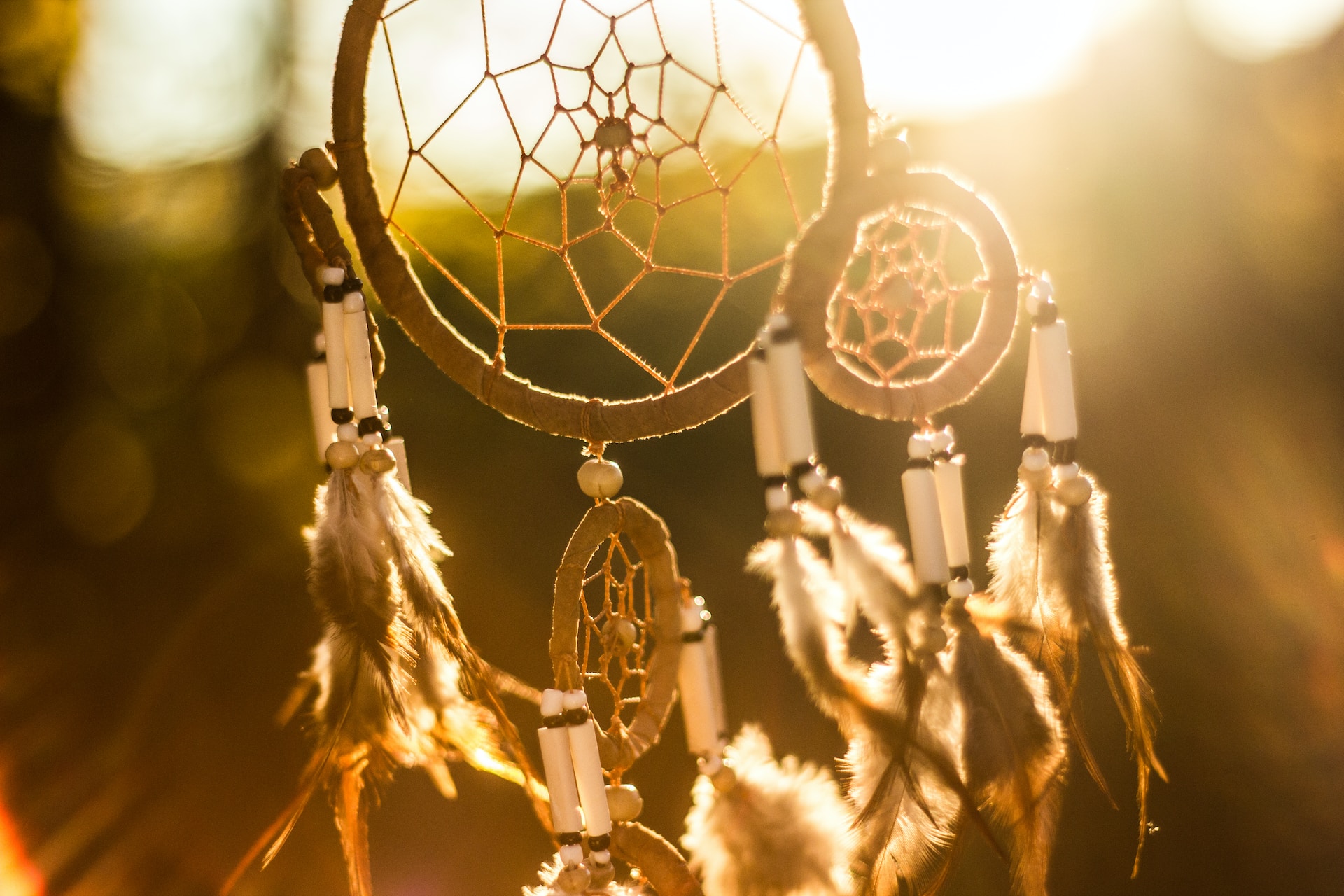

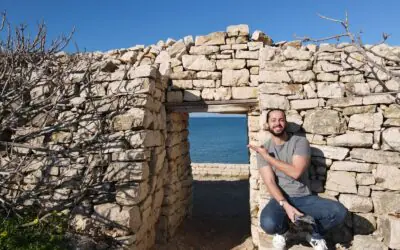
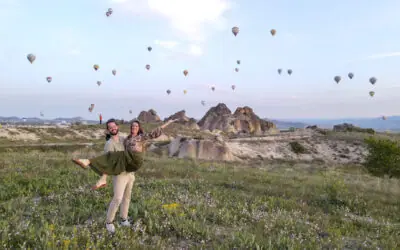

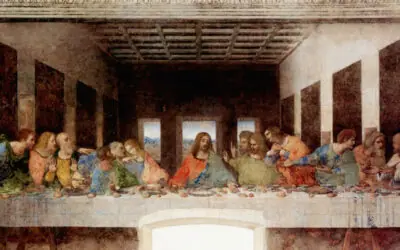

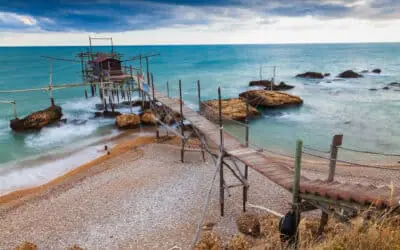
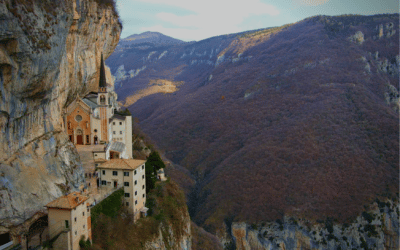
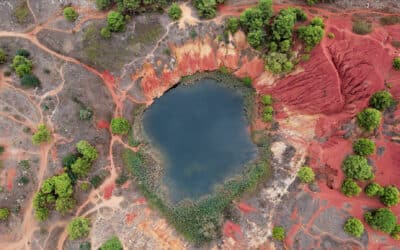
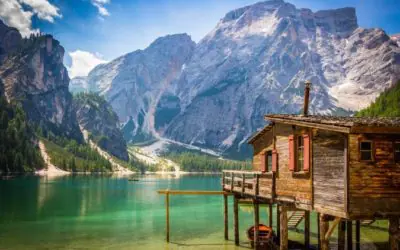
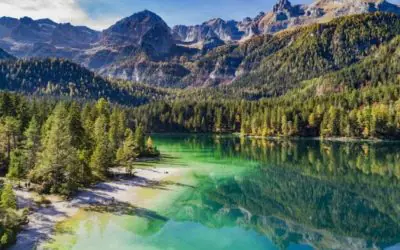
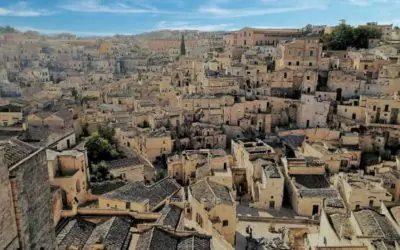
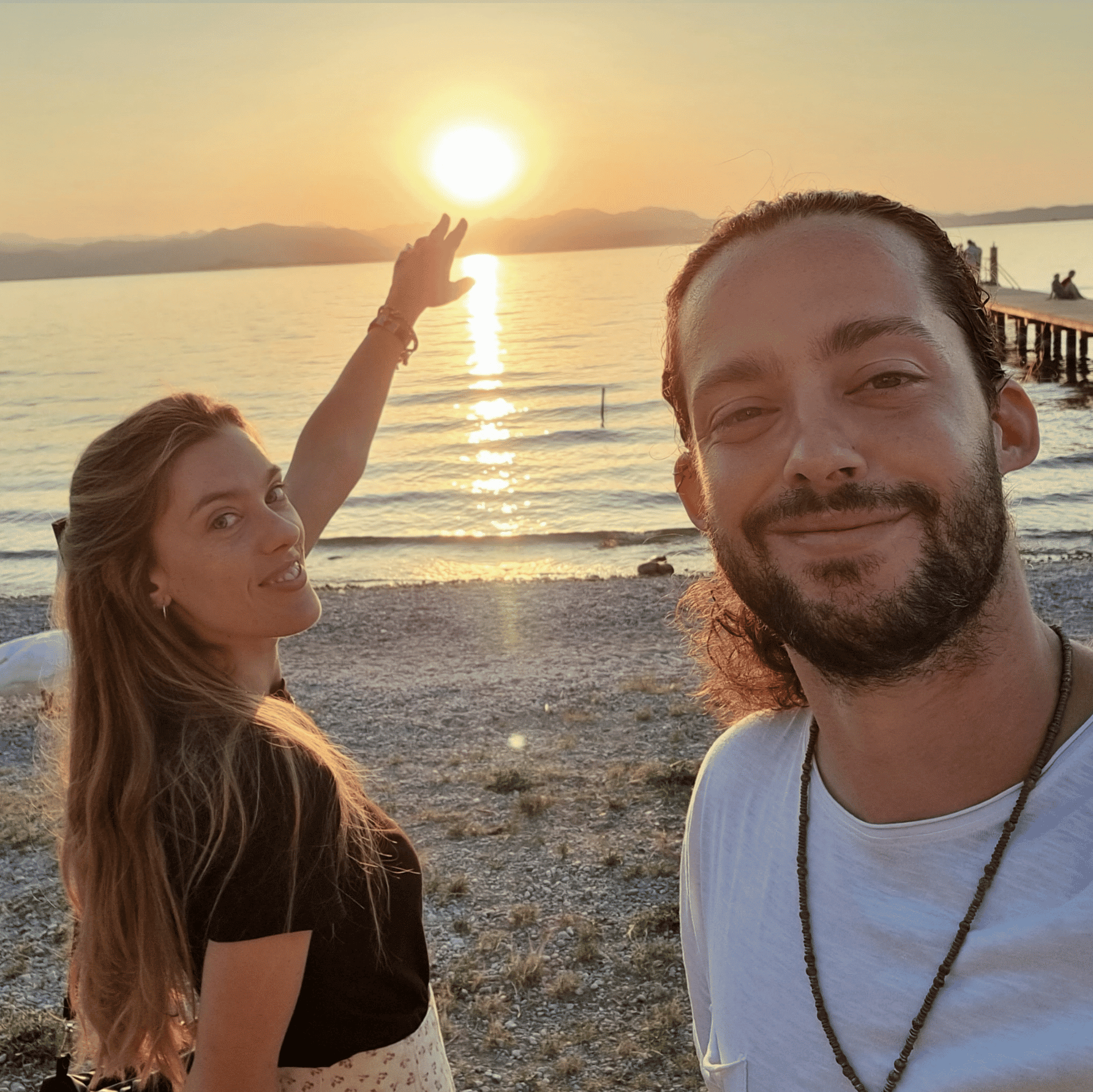
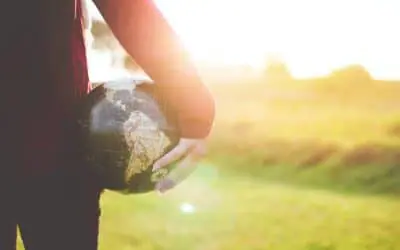



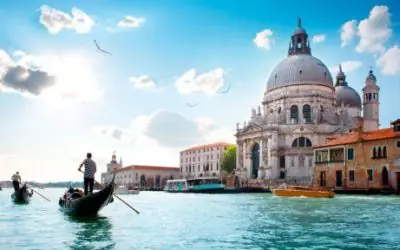
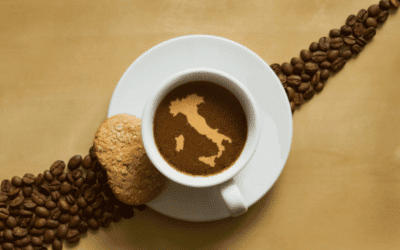
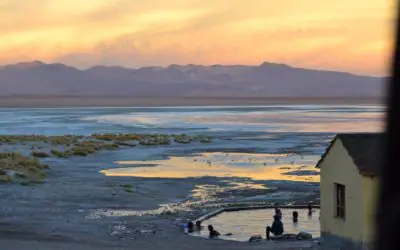
It’s interesting to learn that dreamcatchers are not just delicate ornaments but ancient amulets with a meaningful story. It explains that dreamcatchers, which have become popular decorations, hold a deep and mystical history. Many of us have probably seen them in various places like beach bars, travelers’ homes, or even campervans.
Hi Muskoka! 😀 Indeed, it’s curious how the knowledge about their origin got lost in just a few decades, and how much this extravagant decorations moved the curiosity of different cultures around the world which started to adopting them, customizing them and somewhat making part of their cultures too 🙂